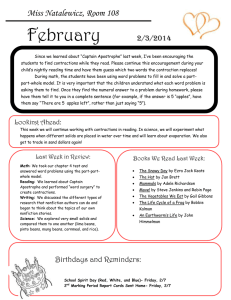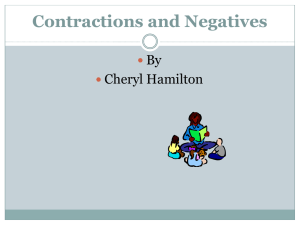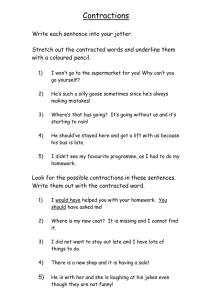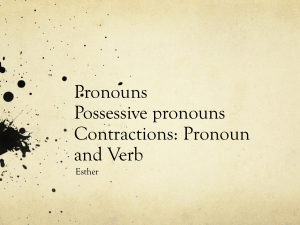Contractions Weak and strong forms written with an apostrophe
advertisement
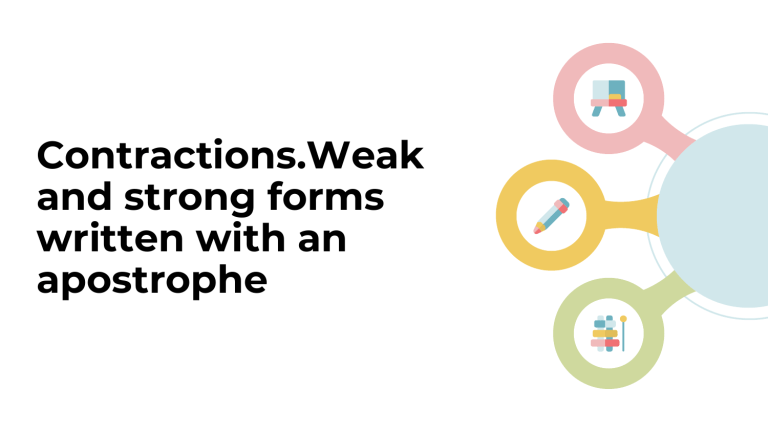
Contractions.Weak and strong forms written with an apostrophe Introduction to Contractions There are two types of contractions: weak forms and strong forms. Weak forms are used in unstressed syllables, while strong forms are used in stressed syllables. The use of contractions is common in spoken English. They are shortened forms of helping verbs and pronouns, where the omitted letters are replaced with an apostrophe. Contractions are an important aspect of conversational English and understanding the distinction between weak and strong forms is essential for effective communication. Understanding Weak and Strong Forms In English, contractions are commonly used to combine two words into one, with an apostrophe taking the place of the missing letters. Weak forms occur when a word is reduced in a sentence, usually in unstressed syllables. For example, the word 'is' becomes 'iz' in weak form. Strong forms, on the other hand, are used in stressed syllables. Understanding weak and strong forms is crucial for mastering English pronunciation and fluency. Knowing when to use weak and strong forms can greatly improve your spoken English and help you sound more natural and fluent. Practice listening to and imitating native speakers to improve your grasp of weak and strong forms. Key Differences in Pronunciation Weak forms refer to the reduced or unstressed pronunciation of a word within a sentence, often found in unstressed syllables or in connected speech. 01 03 On the other hand, strong forms are the full and clear pronunciation of a word, typically used when the word is stressed or emphasized in a sentence. 02 Contractions are a combination of words, often written with an apostrophe, and have weaker pronunciation due to the omission of certain sounds. Apostrophe Usage in Contractions 1 2 3 Weak forms are used in informal speech and reduced forms of words, such as 'gonna' for 'going to'. Strong forms, on the other hand, are used in formal speech and emphasize the full pronunciation of words. Contractions are a combination of words where one or more letters are dropped and replaced with an apostrophe. They include both weak and strong forms, each serving different purposes in spoken and written English. Apostrophe usage in contractions is a crucial aspect of English grammar, allowing for the natural flow of speech while also conforming to written language standards. Understanding weak and strong forms is essential for Examples of Weak Forms In English grammar, weak forms are sounds of vowels known as schwa. It occurs in unstressed syllables and has a neutralizing effect on the vowel sounds. For example, in the word 'to', the weak form is /tə/. It sounds like 'tuh' and is produced with less force and shorter duration. Contractions like 'I'm', 'they've', and 'she's' also use weak forms, which are written with an apostrophe to indicate the omitted sounds. Examples of Strong Forms The weak forms of contractions are often used in casual speech and reduce the prominence of the words, while the strong forms are used for emphasis. In English, contractions are combinations of words that are shortened by dropping one or more letters and replacing them with an apostrophe. Examples of strong forms include 'can't' and 'won't', where the apostrophe replaces the missing letters and the words are pronounced with more emphasis. Commonly Confused Contractions Contractions, which are formed by combining two words and substituting an apostrophe for the omitted letters, may have weak and strong forms. It is important to recognize and use them correctly to avoid confusion and misunderstandings. 1 3 2 Commonly confused contractions, such as 'its' and 'it's', 'you're' and 'your', often cause grammatical errors. Understanding the difference between weak and strong forms can help in using these contractions accurately in writing and speech. By understanding the rules of weak and strong forms of contractions, one can improve their communication skills and avoid common mistakes. It's important to practice using contractions correctly to ensure clear and effective communication. When to Use Weak Forms 1 1 2 Using weak forms in speech, especially in casual conversations, can help you sound more natural and fluent. On the other hand, strong forms are used when emphasizing or stressing a particular word or part of a sentence. Contractions are a combination of two words formed by omitting one or more letters and replacing them with an apostrophe. Weak forms are used in unstressed syllables, whereas strong forms are used in stressed syllables. 3 2 3 Understanding when to use weak and strong forms is essential for clear and effective communication. It can greatly impact the rhythm and flow of your speech, as well as how well you are understood by others. When to Use Strong Forms 01 Contractions are a combination of words where one or more letters are dropped and replaced with an apostrophe. Weak forms are used in unstressed syllables, while strong forms are used in stressed syllables. 02 It's important to use strong forms when you want to emphasize a word or when it's at the end of a sentence. Weak forms are used in everyday speech and informal writing. 03 Understanding when to use strong forms and weak forms can help you improve your pronunciation and sound more natural when speaking English. Practical Tips for Using Contractions When using contractions, it's important to understand the difference between weak and strong forms, which are typically written with an apostrophe. This distinction impacts the overall tone and pronunciation of the words. By mastering the practical tips for using contractions, you can enhance your language skills and ensure that your communication is both clear and engaging. Embracing contractions will also make your writing and speech more conversational and relatable. To effectively use contractions, it's crucial to practice and familiarize yourself with the weak and strong forms. This will help you communicate more naturally and understand the nuances of the English language. Exercises for Practicing Weak Forms 1,2,3 This slide focuses on contractions and weak and strong forms written with an apostrophe. It offers exercises for practicing weak forms to improve pronunciation and fluency. Students will have the opportunity to practice and understand the difference between weak and strong forms through various exercises provided in this slide. By engaging in these exercises, learners can enhance their speaking skills and gain confidence in using contractions and weak forms effectively in communication. Exercises for Practicing Strong Forms The slide 'Contractions.Weak and strong forms written with an apostrophe Exercises for Practicing Strong Forms' focuses on the usage of weak and strong forms of contractions. It provides exercises to practice using strong forms of contractions, helping learners to distinguish between weak and strong forms in spoken English. By practicing strong forms, learners can improve their understanding of spoken English and enhance their communication skills in various contexts. Contractions in Everyday Conversations Weak forms and strong forms are the two ways in which contractions are pronounced in English. The weak forms are more casual and informal, while strong forms are used in more formal settings. 01 03 Understanding contractions and their weak and strong forms is important for English language learners, as it can greatly improve their ability to comprehend and participate in natural conversations. 02 Contractions are a common feature in everyday English conversations. They are created by combining two words and replacing some letters with an apostrophe to form a shorter expression. Contractions in Written Communication 1 2 3 Understanding the difference between weak and strong forms is crucial for clear and effective communication. It impacts the tone and delivery of written content, influencing how the message is perceived by the audience. Contractions in written communication often use apostrophes to represent missing letters or sounds. These contractions can be either weak or strong forms, indicating different levels of emphasis and pronunciation. By mastering the use of contractions and their respective weak and strong forms, writers can enhance the rhythm and flow of their writing, creating a more engaging and impactful communication style. Regional Variations in Contractions Contractions, written with an apostrophe, exhibit variations in pronunciation across regions. These variations in weak and strong forms reflect the diversity of language usage among different cultural and geographical contexts. In some regions, weak forms of contractions may be more prevalent, while in others, strong forms may dominate. This diversity adds richness and complexity to the way language is spoken and understood in various communities. Understanding these regional variations in contractions is crucial for communication and language learning. It allows individuals to appreciate the intricacies of language and adapt their speech patterns to effectively engage with diverse linguistic environments. Impact of Contractions on Language Flow Weak forms occur in unstressed syllables, resulting in reduced vowel sounds and a less prominent pronunciation. Strong forms, on the other hand, are used in stressed syllables and have a clearer enunciation. Contractions, written with an apostrophe, consist of weak and strong forms that impact language flow. Understanding these forms is crucial for effective communication and natural sounding speech. The use of contractions not only affects the rhythm and flow of speech, but also contributes to the overall expressiveness and naturalness of communication. Mastering these forms is essential for fluency in language. Thank you for your attention
